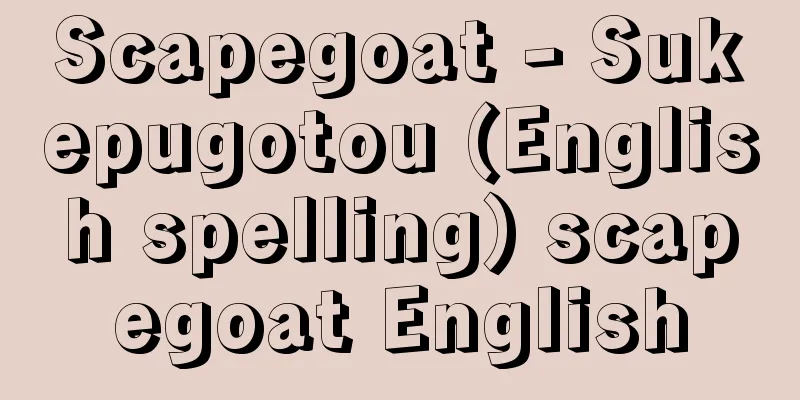Scapegoat - Sukepugotou (English spelling) scapegoat English

|
A scapegoat. A sacrificial goat. In ancient Judaism, according to the Old Testament's Book of Leviticus, once a year the Jews would atone for their sins by substituting a goat for the sins of the Jews and releasing it into the wilderness in a ritual. From this story, the term scapegoating is used to refer to the act of diverting the hatred, resentment, hostility, and aggressive impulses that arise from the suffering, anxiety, fear, frustration, and guilt of individuals, groups, or nations from their original causes, transferring them to weak or deviant people who have no justification and are unlikely to retaliate or fight back, and sacrificing them as targets for blame and attack. The target chosen as a substitute is the scapegoat. As Hitoshi Imamura (1942-2007) states, the scapegoat is an ambiguous entity, and although he is a sufferer and victim, "in the eyes of those within the community, he is feared as someone who embodies (initiates) violence." This recognition of the problem resonates with the issues raised by Masao Yamaguchi (1931-2013), who opened up new horizons in scapegoat theory by introducing the perspective of potential provocation, and Yujiro Nakamura (1925- ), who used the concept of vulnerability to shed light on the scapegoat phenomenon from behind the scenes. Scapegoats are easily selected based on prejudice and discrimination, and victims are often not only subjected to verbal criticism and attacks, but also to physical harm and social sanctions. The Jews persecuted by the Nazis and the Koreans massacred during the Great Kanto Earthquake are both tragic examples in modern history. When rulers or those in power are faced with a crisis, they often scapegoat certain ethnic minorities, minority groups in society, or deviants, and skillfully transfer the people's dissatisfaction, anger, anxiety, and despair onto the scapegoat in an attempt to overcome the political, economic, and social crisis. Scapegoating is becoming increasingly important as a method of mass manipulation in modern society. There are three types of scapegoating. The first is the obsessive type, where a person believes they are being threatened by another person, and is driven by a kind of persecution complex to make that other person the scapegoat. When there is a poor outlet for repressed unconscious impulses and frustration builds up without being fully resolved, the obsessive type is likely to occur. The second is the conformity type, where a person follows social customs of intolerance and discrimination against ethnic and minority groups. Conformity types generally follow the behavioral patterns of the majority, which have social legitimacy, in order to maintain their own social status. The third is the calculating type, typified by demagogues. It is used as a means to acquire and maintain power, and scapegoats are tactically targeted for calculating reasons such as deflecting criticism and attacks directed at oneself, indirectly transferring the hatred and resentment of the people to political opponents who must be defeated in order to seize power, and psychologically uniting nations and groups that are composed like a mosaic of diverse and heterogeneous ethnic groups, and gaining their unified support. Miyagi Otoya (1908-2005) translates scapegoating as demonizing. [Naoyuki Okada] "The Psychology of Prejudice, by G.W. Allport, translated by Haratani Tatsuo and Nomura Akira, combined edition (1961, 1968, Baifukan)" ▽ "The Aggressor, by A. Mitscherlich, translated by Takeuchi Toyoji (1970, Hosei University Press)" ▽ "The Japanese Scapegoat, by Fujitake Akira (1978, Kodansha)" ▽ "Yamaguchi Masao, 'Towards a Poetics of the Scapegoat' (included in 'Poetics of Culture 2', 1983, Iwanami Shoten)" ▽ "The Scapegoat, by R. Girard, translated by Oda Toshikazu and Tominaga Shigeki (1985, Hosei University Press)" ▽ "Nakamura Yujiro, 'Scapegoat' (included in 'Terminology - Words of Interest', Iwanami Shinsho)" [References] | | | |Source: Shogakukan Encyclopedia Nipponica About Encyclopedia Nipponica Information | Legend |
|
贖罪羊(しょくざいよう)。いけにえの山羊(やぎ)。古代ユダヤでは『旧約聖書』「レビ記」の定めに従って、年に一度ユダヤ人の罪業(ざいごう)を山羊に身代りさせ、荒野に放つ儀式を行うことで、自らの罪科を贖(あがな)ったという。この故事から転じて、個人、集団、あるいは民族の苦難、不安、恐怖、欲求不満、罪意識から派生する憎悪、反感、敵意、攻撃的衝動を本来の原因からそらし、なんのいわれもない、報復や反撃の可能性の少ない弱者や逸脱者に転嫁し、非難と攻撃の標的として血祭りに上げることをスケープゴート化といい、身代りとして選ばれるターゲットが、スケープゴートである。今村仁司(ひとし)(1942―2007)が述べているように、スケープゴートは両義的存在者であって、受難者・犠牲者であるにもかかわらず、「共同体内部の人間の眼には暴力を体現する(発動する)ものとして恐れられる」。この問題認識は、スケープゴート論に潜在的挑発性という視点を導入して新たな地平を切り開いた山口昌男(1931―2013)や、バルネラビリティ(攻撃誘発性)の概念を援用してスケープゴート現象を裏から照らし出した中村雄二郎(1925― )の問題提起と響き合っている。スケープゴートは偏見と差別によって選別されやすく、被害者は単に言語的非難・攻撃にさらされるだけでなく、身体的危害や社会的制裁を受けることも少なくない。ナチスによって迫害されたユダヤ人や関東大震災時に虐殺された朝鮮人は、いずれも現代史上における痛ましい事例である。支配者や権力者は危機的状況に陥る場合、しばしば特定の少数民族、社会の少数者集団や逸脱者をスケープゴートに祭り上げて、民衆の不平不満、憤怒、不安、絶望などを巧みにスケープゴートに転移し、政治的、経済的、社会的危機を乗り越えようと試みる。スケープゴート化は現代社会における大衆操作の手法として、ますます重要性を高めている。 スケープゴート化には三つの形態がある。第一は強迫型で、他人から脅かされていると信じ込み、一種の被害妄想(もうそう)に駆られて、その相手をスケープゴートにするタイプである。抑圧された無意識的な衝動のはけ口が貧弱で、欲求不満が十分に解消されぬままに蓄積されると、強迫型になりやすい。第二は同調型であって、少数民族や少数者集団への不寛容と差別という社会慣習に追従する場合である。同調型は一般に自己の社会的地位を保持するために、社会的正統性をもつ多数派の行動様式に従うのである。第三は扇動家を典型とする打算型である。権力の獲得・維持の手段として用いられ、自らに向けられた批判や攻撃をそらすとか、権力を掌握するのに打倒しなければならぬ政敵に、民衆の憎悪や反感を誘導的に転嫁するとか、多様で異質な民族でモザイクのように構成された国家や集団を心理的に結合し、その統一的支持を得るためにといった打算的配慮から、戦術的にスケープゴートをねらい撃ちにするのである。宮城音弥(おとや)(1908―2005)はスケープゴート化を悪玉化と訳している。 [岡田直之] 『G・W・オルポート著、原谷達夫・野村昭訳『偏見の心理』上下、合本版(1961、1968・培風館)』▽『A・ミッチャーリヒ著、竹内豊治訳『攻撃する人間』(1970・法政大学出版局)』▽『藤竹暁著『日本人のスケープゴート』(1978・講談社)』▽『山口昌男「スケープゴートの詩学へ」(『文化の詩学2』所収・1983・岩波書店)』▽『R・ジラール著、織田年和・富永茂樹訳『身代りの山羊』(1985・法政大学出版局)』▽『中村雄二郎「スケープ・ゴート」(『術語集――気になることば』所収・岩波新書)』 [参照項目] | | | |出典 小学館 日本大百科全書(ニッポニカ)日本大百科全書(ニッポニカ)について 情報 | 凡例 |
Recommend
Monkey young - Saruwaka
A role in early Kabuki and the name of a Kyogen p...
Cinclus leucocephalus (English spelling) Cinclusleucocephalus
… [Takashi Saito]. . . *Some of the terminology t...
Marsia
…Anis was a poet active during the reign of the I...
Jan Huyghen van Linschoten
Around 1563 to 1611 Dutch navigator. He was the fi...
Inner London
Greater London, the administrative region of Grea...
Ezo Banryudo Cave
...Rice farming is the mainstay of agriculture, b...
Patriotic Party
...The democrats demanded democratic reforms and ...
Emperor Hanazono's Diary - Hanazono Tennou Nikki
The diary of Emperor Hanazono. It is also called &...
Takahashi Tetsu
1907-1971 A Showa-era novelist and sex customs re...
North Pole - N pole
...The force (magnetic force) acting between magn...
Kuleshov, LV (English spelling) KuleshovLV
...And so, Pudovkin and Eisenstein created and fo...
Gum guayule (English spelling) gumguayule
…This raw rubber is used as a raw material, and w...
Alfourou
...The name that Indonesians generally use to ref...
Alidade (English spelling)
An instrument used in plane table surveying, also ...
Kagano Kukedo
A scenic spot on the Sea of Japan coast of the ...








![Kawai [town] - Kawai](/upload/images/67cb45b33935e.webp)
